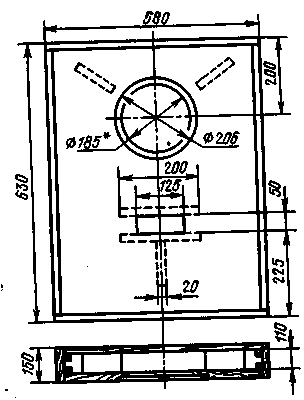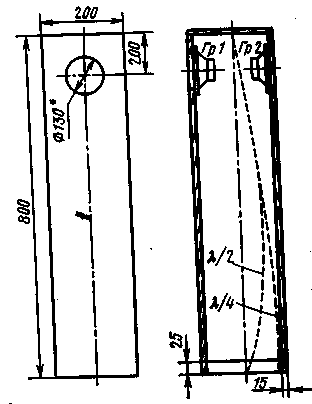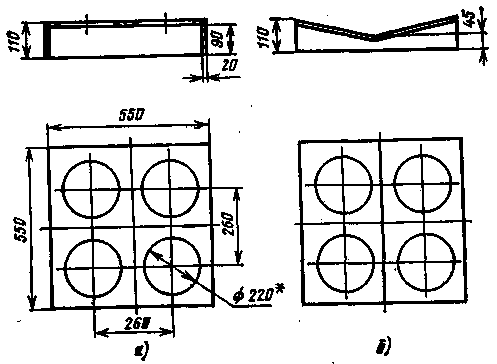Acoustic design dynamic heads consists of a box or screen, designed to align the amplitude-frequency characteristics of the heads in the lower frequency sound range. Dynamic head, not having acoustic design, do not work well at lower frequencies. The main reason for this is that the front and back surfaces of the diffuser head excite sound waves are equal in amplitude but opposite in phase. At lower frequencies, where the radiation of non-directional, anti-phase oscillations are summarized and compensate each other, resulting in drops sharply acoustic efficiency of the head.
To eliminate interference oscillations excited by front rear surfaces of the diffuser, the dynamic head can be placed in the simplest case, in the center of the square screen, made of thick plywood or chipboard dimensions LхL in m, where L=0,06/Fmin. Here Fmin is the minimum frequency of the reproduced signal, kHz.
For example, if the minimum frequency of 50 Hz signal this formula determines each side of the square equal to 1.2 m. it is clear that use broadband head in such a bulky acoustic design uncomfortable. Therefore, acoustic screens in Amateur designs are rare. Instead, they find wide application of various multifaceted boxes I Ko. timid with the rear wall. It should be noted that the design of acoustic design dynamic heads requires complex calculations and accurate information about the characteristics of the head. Consideration of these issues is beyond the scope of this book. Below are the examples of how foreign radio Amateurs perform acoustic design of broadband heads.
The ultra low profile vented
The inverters are called boxes, made of thick plywood or other similar wood material (pine boards, chipboard), in which there are two holes. One is to install the drivers, the other for the implementation of the acoustic coupling of the internal volume of the box with the external environment. When selecting the certain correlation between the size of the diffuser head, the second hole and the drawer, taking into account the frequency properties of the head to ensure that the low frequency oscillations excited by the rear surface of the diffuser head, the output of the second bass ports will be in phase with the oscillations excited by the front surface of the diffuser. This remarkable property of the port for a long time and is widely used in Amateur and professional installations.
The inverter has one drawback-the complexity of a box, similar in shape to a cube. In this respect, noteworthy is the low profile design of the phase inverter. Design drawing is shown in Fig.1.

Fig.1
As follows from the description of the original, the body of the bass reflex box is harvested from dry pine boards or cuts chipboard thickness of about 20 mm dimensions HH mm Enclosure is designed for installation in him wideband drivers, similar domestic head type GD-35 or HD-36. Bass port has a size h mm and is under the hole for the head. DiffuseMaterial heads are fixed on the outside, flush, reducing losses at all frequencies. To eliminate unwanted oscillations of the front and rear surfaces of the case there are five spacers, indicated in the drawing Fig.1 dashing rains, which connect the front and rear walls. Strut size HH mm are made from the same material as the body of the box. Connect the parts of the case with screws and microclean.
The external finish of the body is reduced to drape the front panel radiomenu, preferably loose, and pasting of walls decorative film or veneer. The bass fits well into the interior of the modern room and can be placed directly against the wall. For a stereo setup, you will need two speakers. When repeating the design should specify the size of planting holes for a specific type of dynamic heads. In addition to the above, this can involve heads type GD-4, GD-7, HD-28.
Speaker - pipe organ
High requirements to the quality of an acoustic drum set, on the one hand, and the limited area of the premises that can be placed loudspeakers, on the other, forcing designers to look for solutions that meet these requirements, or to find an acceptable compromise. In this respect, of particular interest is the design of a single-band broadband speaker with two dynamic heads included in phase, sequentially. The loudspeaker is described in U.S. Amateur literature. Sketches of the front panel and cross-section shown in Fig.2.

Fig.2
Describe the speaker has .the body in the form of a column with a cross section of 200 x 200 mm, 800 mm with two slits at the base, formed between the floor and shortened by 26 mm side walls, as shown in Fig.2. In the upper part of the housing has two holes to install the drivers on the front and rear walls of the housing. The dimensions of the neck and head features allow you to use in this design domestic dynamic head type DDG-38. The housing walls are made of plywood or chipboard thickness of about 15 mm.
Elongated shape of the speaker enclosure, small floor space occupied by them .allow you to use these speakers in stereo and Quad units. In addition, the speaker described design provides improved efficiency at lower frequencies and extended beam in the horizontal plane.
The first advantage is due to the phenomenon of standing waves observed inside the speaker enclosure, which behaves like an organ pipe, tuned to a frequency of about 100 Hz. That frequency along the body of the loudspeaker is placed one-quarter wave, which promotes lower frequencies. At a frequency twice that of equal to 200 Hz, on the contrary, the length of the housing is placed exactly half the wavelength. The observed suppression of radiation from the lower part of the body that eliminates unpleasant muttering sound, characteristic of an acoustic kit with large linear dimensions.
The second advantage associated with the use of two heads, radiating in opposite directions. Changing the direction of radiation of the columns by rotating them relative to the longitudinal axis, it is possible to achieve the best sound in the conditions of a particular room. This should not regret that half of the radiated power is directed in the opposite direction relative to the listener. The lower and mid frequencies Bouncing off the walls and furniture, to give multiple re-radiation of sound, like blurring the small size of the actual sound sources and creating the impression of surround sound.
Speaker - emitter group
Group emitter is called a set of homogenous dynamic heads, arranged in a single plane at a certain distance from each other and connected in-phase, series or parallel or series-parallel. To ensure good operation of the loudspeaker type emitter group requires that all heads were of the same type and to each head was fed the same amount of power. Non-compliance or violation of correlation of the work of heads reduces the efficiency of emitter group.
The wide distribution of the mid-woofers abroad for several reasons. The first is that with a few small power heads you can create a loudspeaker high power. So, in the Swedish Amateur radio magazine published descriptions Amateur loudspeakers containing up to 6-8 of the same type of broadband head (20 watts each. Such speakers can work with amplifiers with output power up to 100-200 watts.
Another reason for the spread group of emitters is inherent improve efficiency at medium and especially the low frequencies. This improvement is due to the increase in the area of aperture of the cone is proportional to the number of heads. At the lowest frequencies, this increase is 6 dB for the four heads, 8 dB for six and 9 dB for eight. This occurs due to the expansion of the effective frequency in the lower frequency area by about a third or half octave compared with the bandwidth of a single head in the same design.
The third reason is that the width of the hull of such a loudspeaker can be 1,5-2 times less than the loudspeaker, single-head, i.e. group the emitter can be quite flat and it can be placed on the floor near the wall or even hang on the wall.
We will discuss two versions of loudspeaker design type emitter group containing four dynamic head 6 watts each. These speakers are the most convenient to use low-frequency driver type GD-2. When reducing the diameters of the holes you can use heads type GD-4 or HD-7, HD-AV. HD-35, HD-36. Preference should be given to the first and the last two heads.

Fig.3
The design of the shell of both options is shown in Fig. 3,a and b. The housing is made of chipboard .plate thickness of 20 mm. collect Details on screws and glue. The difference is in the shape of the front wall of the figures. 3,and it is flat in Fig. 3,6 - slightly folded in the middle. Both designs have similar characteristics in the lower frequencies, the Results of the author's calculations shown in Fig.4, which shows that a marked increase in the impact heads when the distance between the centers of the diaphragm equal to 260 mm, observed since the signal frequencies below 600 Hz.

Fig.4
The main advantage of a speaker with an angled front panel (Fig. 3,b) is slightly better uniformity of radiation on the middle and upper frequencies in both planes. The loudspeaker with a flat front panel (Fig.3,a), on the contrary, chart radiation at these frequencies is narrowed.
Widely used in recent years a group of emitters, they are often popolzuyut as emitters lower frequency systems with multiple strips of split-frequency signal. Such systems are designed for input power up to 50-100 watts and more widely used for scoring pop, dance halls and discos.
Literature:
Publication: N. Bolshakov, rf.atnn.ru






